Half a decade ago, chemist Mark Levin was a postdoc looking for a visionary project that could change his field. He found inspiration in a set of published wish lists from pharmaceutical-industry scientists who were looking for ways to transform medicinal chemistry1,2. Among their dreams, one concept stood out: the ability to precisely edit a molecule by deleting, adding or swapping single atoms in its core.
This sort of molecular surgery could dramatically speed up drug discovery — and might altogether revolutionize how organic chemists design molecules. One 2018 review called it a ‘moonshot’ concept. Levin was hooked.
Now head of a team at the University of Chicago in Illinois, Levin is among a cadre of chemists pioneering these techniques, aiming to more efficiently forge new drugs, polymers and biological molecules such as peptides. In the past two years, more than 100 papers on the technique — known as skeletal editing — have been published, demonstrating its potential (see ‘Skeletal editing on the rise’). “There’s a tremendous amount of buzz right now around this topic,” says Danielle Schultz, director of discovery-process chemistry at pharmaceutical company Merck in Kenilworth, New Jersey.
Source: Nature analysis using Digital Science Dimensions database.
To get a sense of the challenge, consider that the small, carbon-based molecules that make up most of the world’s drugs typically contain fewer than 100 atoms, and are assembled piece by piece in a series of chemical reactions. Some connect large sections of the molecule’s skeleton; others decorate that skeleton with clusters of atoms to create the final product. But few methods can reliably tweak a molecule’s core skeleton once it has been assembled. It’s a little like clipping together a house from Lego bricks: remodelling the exterior is trivial, but inserting a brick into the middle of a completed wall can’t be done without taking the house apart.
For organic chemists, the idea of being able to swap an atom in a molecule’s skeleton holds an intrinsic fascination. “It’s almost magical that these changes are now possible,” says Richmond Sarpong at the University of California, Berkeley, a leading light in skeletal editing.
But there’s also a very practical purpose. Drug discovery involves first finding a promising molecule, and then making hundreds of slightly different versions to try to improve potency or reduce toxicity. It’s relatively easy to change atomic groups on a molecule’s periphery to make variants. To edit the core, however, researchers typically must return to the start of their synthesis and make the modified skeleton from scratch. This is expensive, time-consuming and, in practice, heavily limits the variety of designs that drug firms screen and test. Reliable skeletal editing could massively speed up the process (see ‘The emerging chemistry of skeletal editing’).
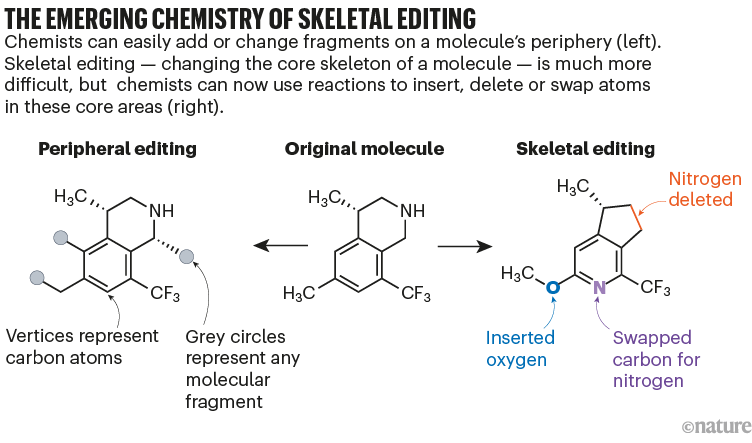
Source: Ref. 9
At this stage, many of these methods only work on specific molecules, or edit them inefficiently. Researchers are excited but also wary of overhyping a young field.
Still, chemists at drug makers Pfizer and Merck are already testing various skeletal editing reactions. “We recognize this could be transformative,” says David Blakemore, head of synthesis, inflammation, immunology and anti-infectives chemistry at Pfizer in Groton, Connecticut. “It’s fairly early days, but I don’t think we’re a long way away from being able to use some of these methods.”
Skeleton keys
To the uninitiated, organic chemistry looks like a baffling parade of hieroglyphs — a blizzard of zigzags and hexagons whirling across the page. Yet these diagrams are a visual lexicon, rich in information about the molecules they represent. Each vertex in a shape represents a carbon atom (accompanied by hydrogen atoms that are not shown), while the lines between them are chemical bonds. Then there’s a liberal seasoning of letters, representing atoms such as oxygen, nitrogen or sulfur, peppered across the molecule’s skeleton and periphery.
When chemists want to make a particular molecule, they start by sketching its structure in this way. Then they progressively carve this drawing into smaller pieces by erasing bonds that could be forged by reliable reactions, leaving simpler fragments that can be bought from chemical suppliers, or brewed up from scratch.
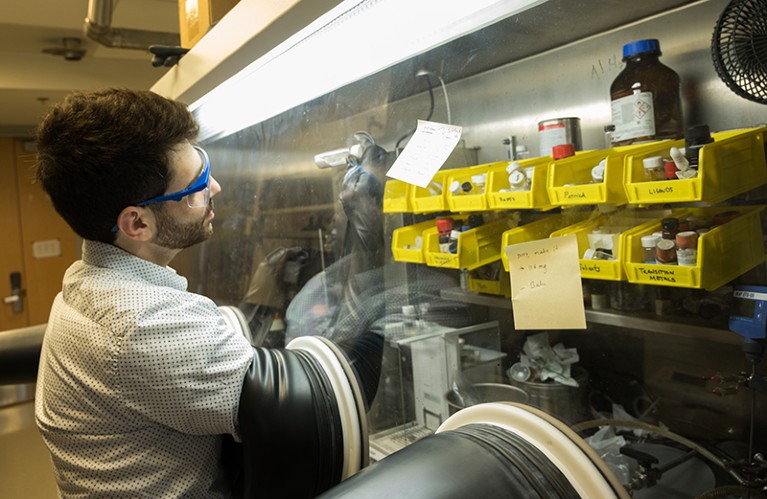
Mark Levin, a pioneer of skeletal editing, working at a glovebox (a sealed container for hazardous or air-sensitive chemistry).Credit: Jean Lachat Photography
Adding a reliable set of skeletal editing reactions to the chemists’ toolkit could provide a completely new set of disconnections, enabling more efficient syntheses and ways to make previously inaccessible compounds. “It’s a very clear departure from how we used to think about synthesis,” says organic chemist Junqi Li at Iowa State University in Ames.
The pay-offs could be enormous. New kinds of chemical reaction that synthesize molecules have transformed drug discovery. The 2005 Nobel Prize in Chemistry went, in part, to researchers who had developed efficient catalysts for metathesis reactions in the 1990s. These weld together chemical groups called alkenes (C=C double bonds); the method was crucial for creating the large molecular rings in a series of hepatitis C drugs, for example. The 2010 chemistry Nobel went to researchers who, in the 1960s and 1970s, had developed palladium-catalysed cross-coupling reactions, offering another way to forge carbon–carbon bonds in drug molecules.
In the twenty-first century, there have been major advances in reactions that edit a molecule’s periphery. Carbon–hydrogen (C–H) bonds are usually passive bystanders in chemistry, but the past two decades have seen a parade of methods (known generally as C–H activation) to replace hydrogen with clusters of atoms that have more useful chemical properties, called functional groups.
If skeletal editing could be applied to a broad range of molecules — adding or removing specific atoms with complete selectivity, and without damaging existing functional groups — the approach would rank alongside those past innovations, says David Rees, chief scientific officer at Astex Pharmaceuticals in Cambridge, UK. “I think it would be potentially even bigger than any of them.”
That, however, is a tough task. It’s perhaps tempting to draw a parallel between skeletal editing and the gene-editing technique CRISPR that has taken biotechnology by storm. In fact, says Levin, it’s a poor analogy. CRISPR only has to cope with the four bases in DNA or RNA — but for skeletal editing to be generalizable, the editing techniques will have to work reliably on thousands of different molecules.
Meeting medicinal needs
The skeletal editing reactions that chemists have unveiled are generally tailored to the needs of medicinal chemists3. Many are designed to edit molecular rings that contain non-carbon atoms (such as O, N or S): known as heterocycles, they are ubiquitous in medicinal chemistry. About 60% of small-molecule drugs contain a nitrogen heterocycle, for example, in part because it often helps a drug to bind well to protein targets4. Medicinal chemists might want to delete one atom from a heterocycle so that the ring contracts, changing its fit for a protein site, or add an atom that strengthens its binding. Alternatively, they might want to tweak the molecule to improve its solubility or reduce its toxicity.
Levin and his group, for instance, have developed a way to insert a carbon atom into a pentagon-shaped nitrogen heterocycle to create a hexagonal one (see ‘Skeletal editing reactions: inserting carbon’). In the biochemical jargon, this transforms pyrroles into pyridines5. “That is a really powerful reaction,” Blakemore says. Pyridines are the second-most-common heterocycle in drugs approved by the US Food and Drug Administration. However, heavily decorated pyridines are much harder to make than the corresponding pyrroles, so Levin’s reaction could offer a much simpler route to those desirable skeletons.
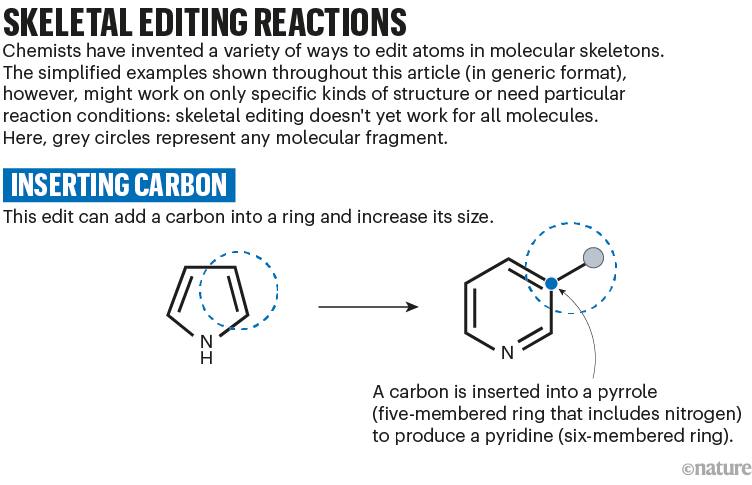
Source: Ref. 5; reaction details omitted.
Julia Reisenbauer, a PhD student working in organic chemist Bill Morandi’s team at the Swiss Federal Institute of Technology in Zurich, has developed a similar reaction to insert nitrogen into various rings6,7 (see ‘Inserting nitrogen’). “For quite a lot of these products, it would have been way harder to access them with known methods,” she says.
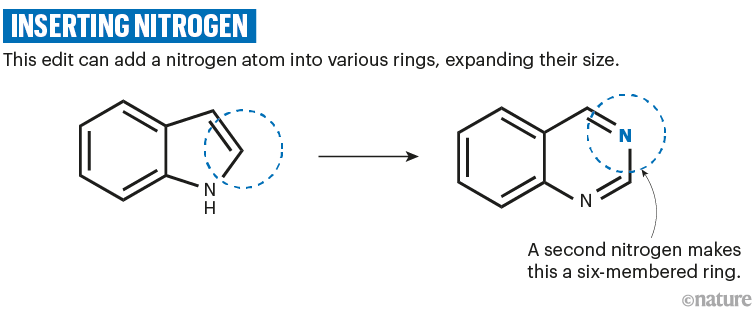
Source: Ref. 6; reaction details omitted.
Medicinal chemists who want to optimize the effects of nitrogen atoms in their drug candidates sometimes perform ‘nitrogen scans’, testing the bioactivity of a series of analogues that each have a nitrogen atom in almost every conceivable position8.
But constructing these variants is time-consuming, and can be chemically challenging: the nitrogen atoms sometimes interfere with the catalysts and chemical reagents used in syntheses, Rees says. Using skeletal editing to insert nitrogen at the end of a synthesis might circumvent that problem, and offer a practical way to perform a nitrogen scan without completely resynthesizing each analogue.
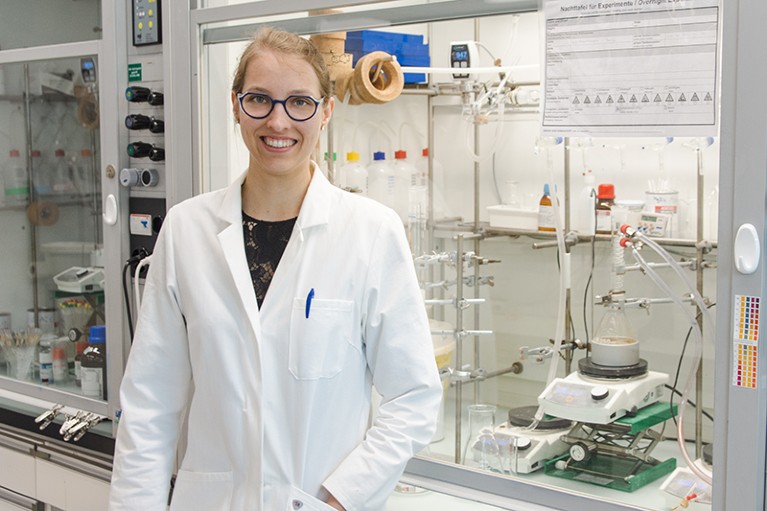
Julia Reisenbauer’s nitrogen-insertion edit could help medicinal chemists to perform nitrogen scans.Credit: Marius Lutz
There’s also a growing selection of deletion reactions, which either shift an atom from a molecule’s skeleton to its periphery, or remove it altogether. Levin and his group have reported a reaction to snip nitrogen out of a C–N–C group, a motif commonly found in drugs9 (see ‘Deleting nitrogen’) — although the reagent they use doesn’t work well with bulkier molecules, and tends to attack some sensitive functional groups.

Source: Ref. 9; reaction details omitted.
Sarpong’s group, meanwhile, has come up with a method to delete a carbon that sits between two nitrogen atoms in six-membered rings called pyrimidines10. (The cytosine and thymine bases in DNA are both pyrimidine structures.)
For some researchers, the most prized skeletal edits would swap one atom for another in a single step. “I’ve been obsessed with this idea of atom replacements in any skeleton,” says Levin.
Last year, Li and her colleague Quang Luu, also at Iowa State University, unveiled a reaction sequence that replaces a carbon atom with oxygen, a change that can potentially improve a molecule’s solubility in water11 (see ‘Oxygen swap’). But so far, the method has been used only on a specific type of molecular skeleton containing a carbon atom flanked by two benzene-based groups. Li has also adapted the approach to replace the carbon atom with boron, an atom that can help drug molecules bind to sugars or proteins.
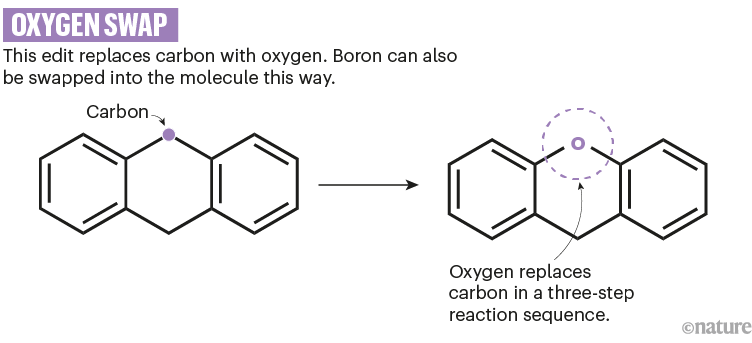
Source: Ref. 11; reaction details omitted.
At Stanford University in California, chemists Noah Burns and Sajan Patel have developed a carbon-to-nitrogen swap that is driven by blue light and oxygen12 (see ‘Nitrogen swap’). However, it also involves a highly reactive compound called an azide that has a reputation for explosive instability.

Source: Ref. 12; reaction details omitted.
For now, “there’s still no general solution” for atom swapping, says Levin. “But we have a couple of things cooking in my lab, which aren’t ready for prime time, that are exact answers to this challenge.”
Warp-speed editing
As with other reactions, all of these innovations use reagents, catalysts or light to push or pull around atoms’ shared electrons — the ‘glue’ that holds atoms together in the chemical bonds of organic molecules — so that new atoms can be brought in or existing ones excised. And some of the editing reactions have deep historical roots — several have enabled skeletal edits since the late nineteenth century. The Baeyer–Villiger oxidation, for example, inserts an oxygen atom; the Beckmann rearrangement inserts nitrogen, a process that every year produces millions of tonnes of caprolactam, the feedstock for nylon. (Like so many reactions in organic chemistry, these reactions bear the names of their inventors).
But these historical approaches have limited scope. They can only insert atoms next to a functional group known as a carbonyl, because they rely on its chemical reactivity to help prise open a molecule. Other skeletal editing techniques developed decades ago are rarely used, because they chew up too many functional groups in molecules or produce messy mixtures that require laborious purification.
Access to modern catalysts and reagents has made improvements possible, says Reisenbauer. For instance, Levin’s and Reisenbauer’s atom insertions both mimic a method from the 1880s: the Ciamician–Dennstedt rearrangement. This reaction tended to damage peripheral functional groups, limiting its use, but the improved approaches use more-forgiving reagents to generate the reactive atoms needed for a clean insertion. “We’re always building on the foundations and discoveries of those that came before us,” says chemist Sarah Wengryniuk at Temple University in Philadelphia, Pennsylvania, part of a team that has developed an oxygen-insertion edit13 (see ‘Inserting oxygen’).
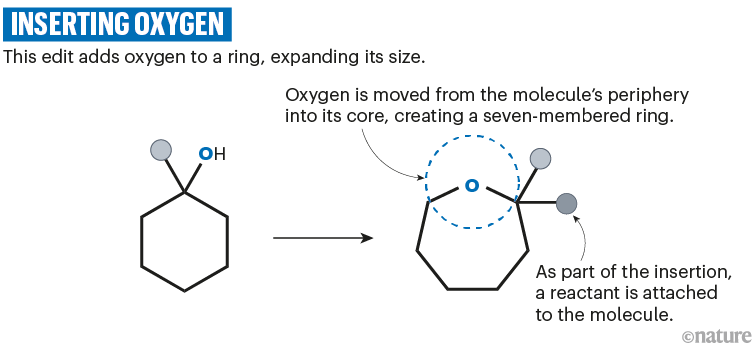
Source: Ref. 13; reaction details omitted.
Another advance lies in the light-driven reactions that break and rejoin atomic bonds. Decades ago, these reactions relied on lamps that produced a broad spread of wavelengths, which sometimes destroyed part of a reaction’s product as soon as it formed. These days, chemists use light-emitting diodes (LEDs) that emit specific wavelengths of light, which can trigger precise edits.
Sarpong has developed a light-driven reaction that cuts out N, O or S from rings, if there is a carbonyl group close to the atom being excised14 (see ‘Another nitrogen deletion’). The key was to use exactly the right wavelength of blue light to excite this carbonyl group and trigger an atom-removing rearrangement.
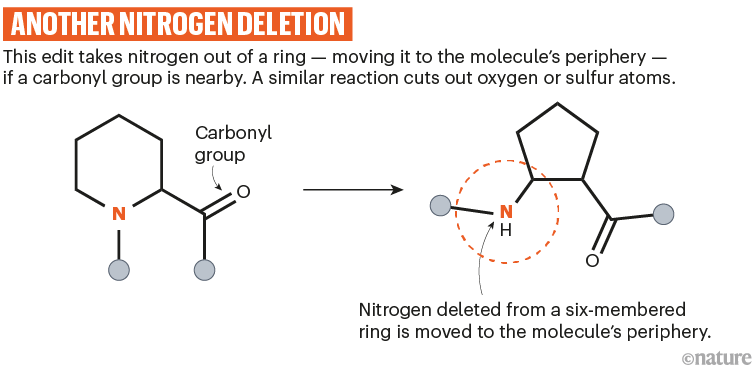
Source: Ref. 14; reaction details omitted.
And Levin’s team, collaborating with scientists at Merck, have developed a reaction that deletes a carbon atom from some nitrogen heterocycles using violet light at a wavelength of 390 nanometres15 (see ‘Deleting carbon’).
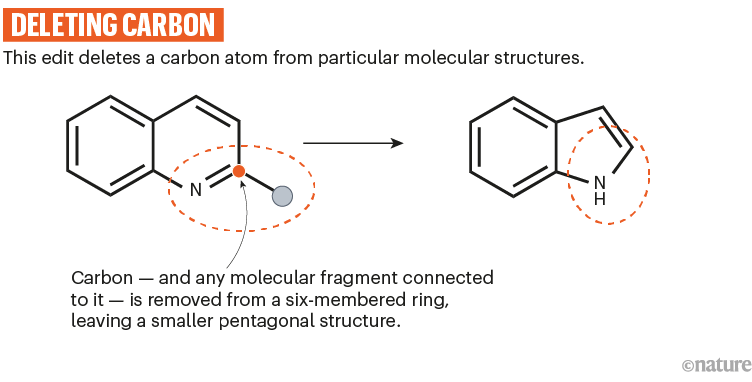
Source: Ref. 15; reaction details omitted.
Bones of contention
Skeletal editing could also assist in the earlier stages of drug discovery — helping medicinal chemists to access a broader range of molecules to screen for drug-like activity.
Chemists imagine the universe of all possible organic molecules as a territory called chemical space. It includes up to 1060 possible drug-like molecules, each a twinkling star of potential medicinal benefit16. Ideally, pharmaceutical companies’ screening libraries should feature representatives from across the chemical cosmos. But, in reality, molecular structures that are easier to make tend to be over-represented in these libraries, leaving large unilluminated voids in medicinal chemical space17.
Skeletal editing could help to push back these frontiers. By offering a one-step method to change the skeleton of a molecule, these reactions act as a wormhole in chemical space, enabling researchers to travel from one galaxy of compounds to another. This strategy is already being trialled in some pharmaceutical companies, Sarpong says (both he and Levin collaborate with Merck researchers).

Chemist Richmond Sarpong, a leading light in skeletal editing.Credit: Brandon Wright
Yet even the most enthusiastic proponents of skeletal editing concede that there are many obstacles to routine use. Some reactions are not very efficient, converting only a fraction of molecules into the desired product. (That might not matter for medicinal chemists, however, because the early stages of drug discovery often require only a tiny amount of a desired molecule.)
Another difficulty is that many edits rely on highly reactive reagents that generate unwanted by-products or might be considered too hazardous in industry. “This is my biggest reservation right now,” says Blakemore. Sometimes, extra molecular fragments have to be pre-installed to protect vulnerable functional groups, and then removed after the reaction is complete. Although this concept is well established in chemistry, it makes the overall editing less efficient.

Sarah Wengryniuk, part of a team that has developed an oxygen-insertion edit.Credit: Courtney Ay Photography
Perhaps the biggest challenge is to make the methods more general, so that each reaction works reliably on a wide range of skeletons. Yet many of the most useful reactions in medicinal chemistry initially had only a limited scope, and there are hints that skeletal editing could likewise become more versatile and convenient.
One promising sign comes from studying how atoms and bonds shift around as reactions progress, forming fleeting intermediate forms called transition states. Some of the skeletal editing reactions share similar mechanisms, suggesting that common, and perhaps generalizable, reaction motifs are at play. Finding milder and more selective reagents to reach these kinds of intermediate might unlock a wider range of edits.
Wider horizons
As chemists work to strengthen the foundations of skeletal editing, these techniques are already reaching areas beyond drug discovery. For instance, polymer chemists Aleksandr Zhukhovitskiy and Rachael Ditzler at the University of North Carolina at Chapel Hill have shown that similar reactions can edit the carbon-based backbones of polymers18. Such reactions might eventually help to recycle plastics, or make it easier to use sustainable biological molecules to produce everyday polymers that are currently made from fossil-fuel feedstocks.
Sarpong has used his light-driven nitrogen deletion to modify the structures of peptides, which are short chains of amino acids. Schultz says that a general method to do this could be incredibly useful. For instance, an oral peptide drug edited to contain non-natural amino-acid structures might be better able to withstand digestive enzymes — without losing its potency. “It could be a pretty game-changing technology,” she says.
Meanwhile, Morandi’s team has inserted unusual isotopes, such as nitrogen-15 or carbon-13, into drug molecules7,19 (see ‘Isotope swap’). Medicinal chemists could use this strategy in experiments to track the metabolism of a drug, for example, or to understand how it interacts with its protein target.
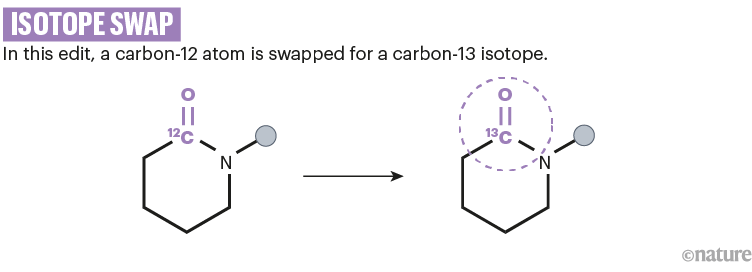
Source: Ref. 19; reaction details omitted.
It’s clear that the skeletal editors are brimming with ideas for new methods, and the field is full of early-career researchers who are competitive but also collaborative. “We want to come in and do something that people recognize as new and interesting and different,” says Levin. “I think it’s the future.”


